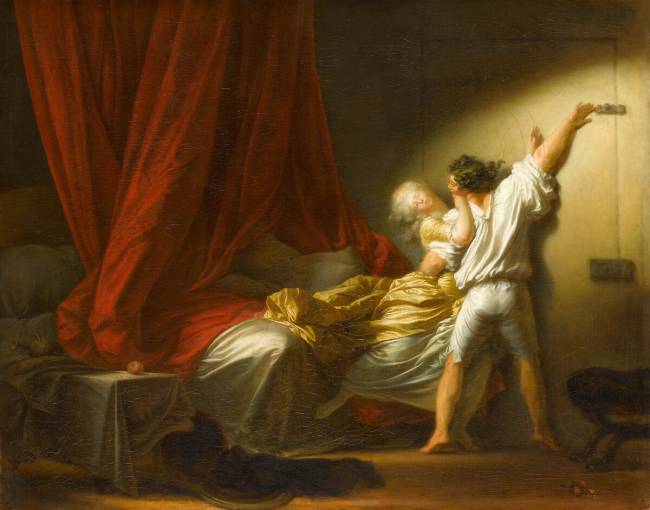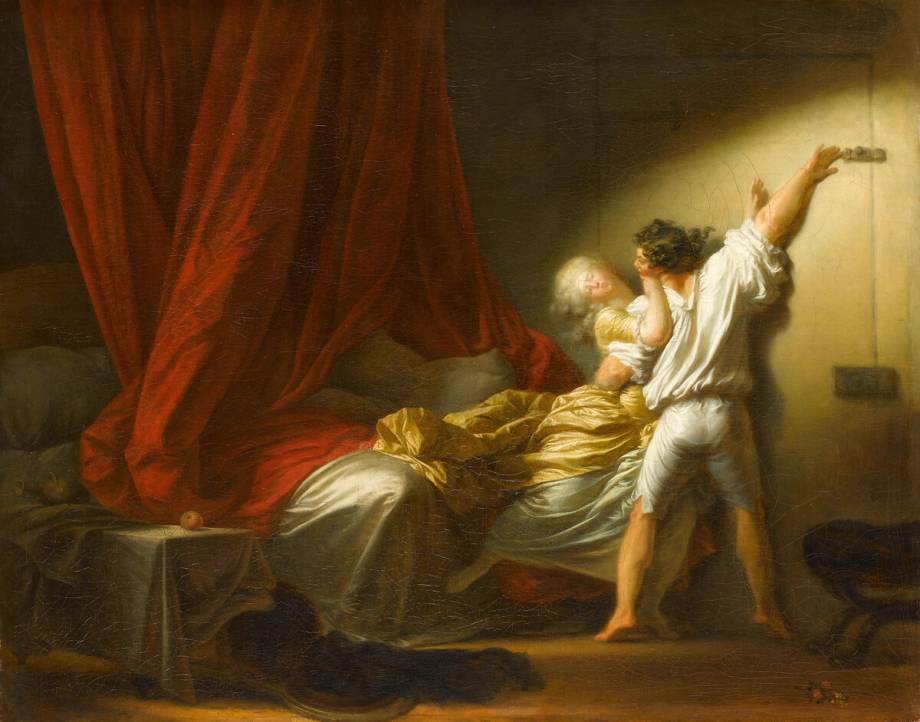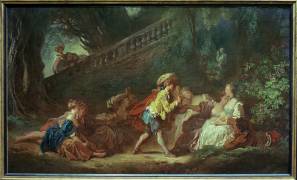Shop art print and framed art The Lock by Jean-Honoré Fragonard
The Lock is also available as...
Cushion
The Lock
The Lock : A masterpiece of furtive love in a libertine context
The Lock, an oil on canvas painted between 1776 and 1779, is set in a historical context where libertinism and amorous intrigue were commonplace in the upper echelons of French society. The 18th century, the Age of Enlightenment, was also a time of gallantry and seduction. Literary salons and boudoirs were meeting places where the art of conversation and courtly love was cultivated. Jean-Honoré Fragonard, a painter renowned for his galant and libertine scenes, met the demand of an aristocratic clientele fond of such representations.
The work was commissioned by the Marquis de Véri, a wealthy collector and art lover known for his libertine tastes. It is now known that The Lock is the counterpart to another work by Fragonard, L'Adoration des bergers, creating a striking contrast between the sacred and the profane, between spirituality and sensuality. This commission testifies to the moral ambiguity of the time, when religion and libertinism could coexist in the intimacy of private collections.
Composition and general mood of Fragonard's The Lock
The Lock sports a relatively intimate format of 73 x 93 cm, and invites the viewer to come closer to grasp every detail. The painting's composition is dynamic and theatrical. Fragonard uses warm, golden light to highlight the luxurious fabrics and pearly skin of the figures. The unmade bed, the fabrics on the floor and the closed door create an intimate, suggestive atmosphere. The flamboyant red of the fabrics descending over the bed contrasts with the softer tones of the rest of the composition, drawing the eye to the center of the action. The pictorial space is constructed diagonally, guiding the viewer's gaze from the lower left corner, where the apple is located, to the couple entwined between the four-poster bed and the door.
The central subject of Lock: a snapshot of stolen love
In the center of the painting, a man and a woman are entwined in a moment of passion. In this scène de genre, typical of 18th-century painting, depicting a moment of gallant seduction in a boudoir setting, the man, dressed in a simple shirt and long breeches, is locking the bedroom door, while the woman, dressed in a gilded-accented gown, tries to hold him back. Their embrace is both tender and passionate. The man's gaze is intense and determined, while the woman's expresses a mixture of desire and resistance. Fragonard captures a snapshot of their intimacy, a moment suspended between the game of seduction and amorous abandon.
Symbolism and interpretation of Fragonard's Lock
The Lock is rich in symbols that help make this painting a fascinating and enigmatic work. The lock, the painting's central element, symbolizes both possession and confinement. It suggests that man seeks to preserve this moment of passion by protecting himself from the outside world. The apple alludes to original sin and temptation. The unmade bed and the scattered fabrics on the floor evoke the act of love that has just taken place or is about to take place. The light illuminating the two lovers highlights the subjects and can be seen as the amorous passion that consumes them.
Impact and posterity of Fragonard's Lock
The Lock is considered one of Fragonard's most famous and accomplished works. Now housed in the Musée du Louvre, it helped establish his reputation as a painter of galant and libertine scenes. However, changing tastes and mores at the end of the 18th century, marked by a return to more moral and austere values, led to a certain disinterest in this type of subject. Fragonard had to adapt to these changes and turn to more classical themes more in line with society's new expectations, which explain the realization of the Lock's counterpart, L'Adoration des bergers.
Despite this change of context, The Lock has retained its place in art history. Today, it is recognized as a Rococo masterpiece, bearing witness to an era when love and sensuality were celebrated with a freedom and audacity that continue to fascinate.
This artwork is a painting from the classical period. It belongs to the rococo style.
« The Lock » is kept at Louvre, Paris, France.
Find the full description of The Lock by Jean-Honoré Fragonard on Wikipedia.
You may also like
- 30% !
Make good deals by browsing our Reserve : editions of our catalog which await their purchaser at a low price.























